Top 10 Digital Marketing Tools for Digital Health Companies
Explore essential digital marketing tools tailored for digital health companies, focusing on compliance, audience engagement, and targeted outreach strategies.

Digital health companies face unique challenges like regulatory compliance, data privacy concerns, and diverse audience needs. To succeed, they need tools that balance compliance, patient engagement, and targeted marketing. Here's a quick look at the top tools:
Key Tools and Features:
- High-Growth Digital: Focuses on compliance and audience targeting for healthcare professionals and patients.
- HubSpot Marketing Hub: Offers marketing automation and lead nurturing but requires extra safeguards for HIPAA compliance.
- Salesforce Health Cloud: Tailored for healthcare with HIPAA compliance and seamless EHR integration.
- Google Analytics 4 (GA4): Advanced analytics for tracking patient journeys but not inherently HIPAA-compliant.
- Doximity: Connects with over 80% of U.S. physicians for targeted outreach.
- Sprout Social: Social media management with tools for secure patient engagement.
- Hootsuite: Social scheduling and compliance tools for regulated industries.
- Marketo Engage: AI-driven campaigns with HIPAA-ready features.
- Veeva CRM for Life Sciences: Built for pharmaceutical and life sciences marketing with compliance at its core.
- Semrush: SEO and content marketing for increasing online visibility.
Quick Comparison Table:
| Tool | Compliance Capabilities | Audience Targeting | Integration with Healthcare Systems |
|---|---|---|---|
| High-Growth Digital | HIPAA-compliant practices | Tailored for healthcare | EHR integration |
| HubSpot Marketing Hub | Requires additional safeguards | Advanced segmentation | CRM integration |
| Salesforce Health Cloud | HIPAA-compliant, secure data | Technical and patient-focused | EHR, HL7 standards |
| Google Analytics 4 | Not HIPAA-compliant | Custom audience tracking | Limited healthcare integration |
| Doximity | HIPAA-compliant platform | Physician-focused | Limited |
| Sprout Social | Limited HIPAA compliance | Social media targeting | Social platform APIs |
| Hootsuite | HIPAA tools like keyword filters | Social engagement | Basic analytics export |
| Marketo Engage | HIPAA-ready with BAA | AI-driven segmentation | Salesforce integration |
| Veeva CRM | FDA, HIPAA, and Sunshine Act | HCP segmentation | Life sciences ecosystem |
| Semrush | GDPR-compliant | SEO and keyword targeting | API integrations |
These tools help digital health companies navigate compliance, engage patients, and target healthcare professionals effectively. Select the one that aligns with your needs and systems.
How to Run the Perfect Healthcare Digital Marketing Program
1. High-Growth Digital
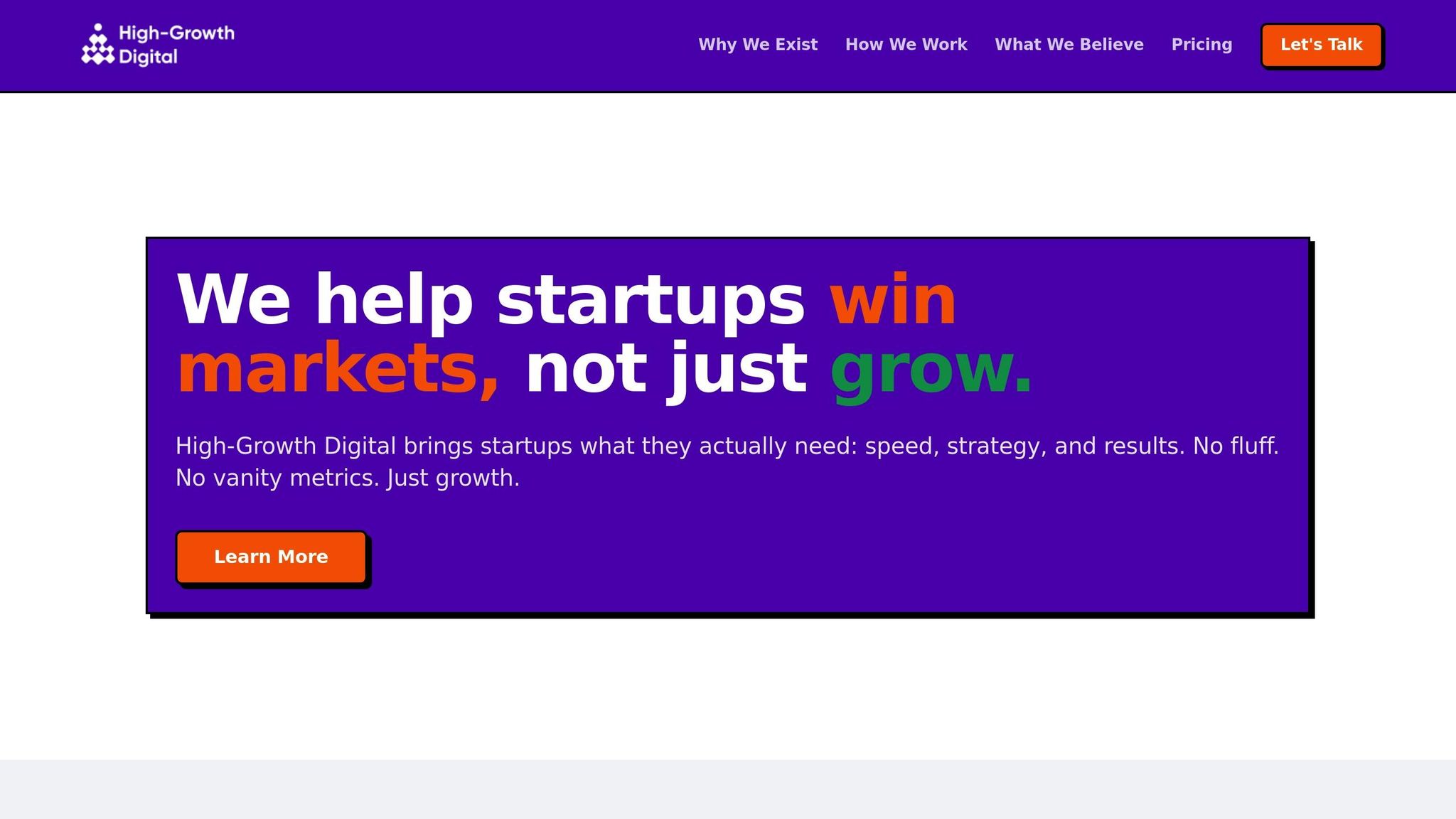
High-Growth Digital is designed specifically for technical founders in the digital health space. Its standout offering, the 90-Day Brand Implementation Sprint, simplifies complex healthcare technologies into clear, impactful messaging. This ensures that both technical and non-technical audiences understand the value of these innovations.
Through its Technical Value Architecture system, the platform helps digital health companies align their advanced products with pressing healthcare needs. With 90% of healthcare executives anticipating a surge in digital technology adoption by 2025[3], the ability to communicate value effectively has never been more critical. Let’s explore how High-Growth Digital integrates compliance and audience targeting to meet these demands.
Regulatory Compliance
Navigating healthcare marketing requires strict adherence to legal and ethical standards. High-Growth Digital embeds compliance frameworks into every aspect of its marketing processes, ensuring promotions are not only effective but also trustworthy. Connor Wilkins, CMO at Direction.com, highlights the importance of compliance in healthcare marketing:
"Healthcare compliance software protects data. It ensures regulatory adherence. It boosts patient engagement. It empowers digital success. It builds trust at every level of care."[5]
The platform guarantees HIPAA compliance by safeguarding patient data, granting access only to authorized personnel[4]. For businesses working with external marketing partners, High-Growth Digital ensures these agencies are trained in HIPAA-compliant practices[4]. Additionally, the system emphasizes obtaining explicit patient consent before using any data for marketing purposes[4]. This comprehensive approach not only protects privacy but also sets a strong foundation for personalized and targeted campaigns.
Technical Audience Targeting and Segmentation
Reaching diverse audiences is a challenge in digital health, but High-Growth Digital’s Brand Translation System bridges the gap. By tailoring content to address the unique needs of both healthcare professionals and patients, the platform enables highly focused campaigns. Studies show that personalized strategies significantly improve patient retention rates[1], underscoring the importance of precise audience segmentation for success in this industry.
Patient Engagement and Personalization Capabilities
The platform’s Marketing Implementation Toolkit is built to enhance patient engagement through advanced personalization. With 77% of patients turning to search engines before making healthcare choices and nearly 90% of U.S. adults searching online for health-related information[7], creating tailored, high-quality content is essential. High-Growth Digital excels in this area by enabling detailed email segmentation and crafting content that addresses specific patient concerns. This not only boosts search engine visibility but also builds trust among privacy-conscious individuals[6].
Integration with Healthcare Data Systems
High-Growth Digital takes its capabilities further by integrating seamlessly with healthcare data systems. Its Sustainable Growth System connects with electronic health records and adheres to HL7 standards, aligning with the growing demand for healthcare data interoperability. This market is expected to reach $19.28 billion by 2028, with a compound annual growth rate of 18.3%[8]. With 95% of U.S. healthcare institutions already utilizing HL7 V2.x standards[9], this integration ensures smooth data communication across medical systems. By leveraging real-time healthcare insights, companies can deliver more targeted and effective marketing campaigns.
2. HubSpot Marketing Hub
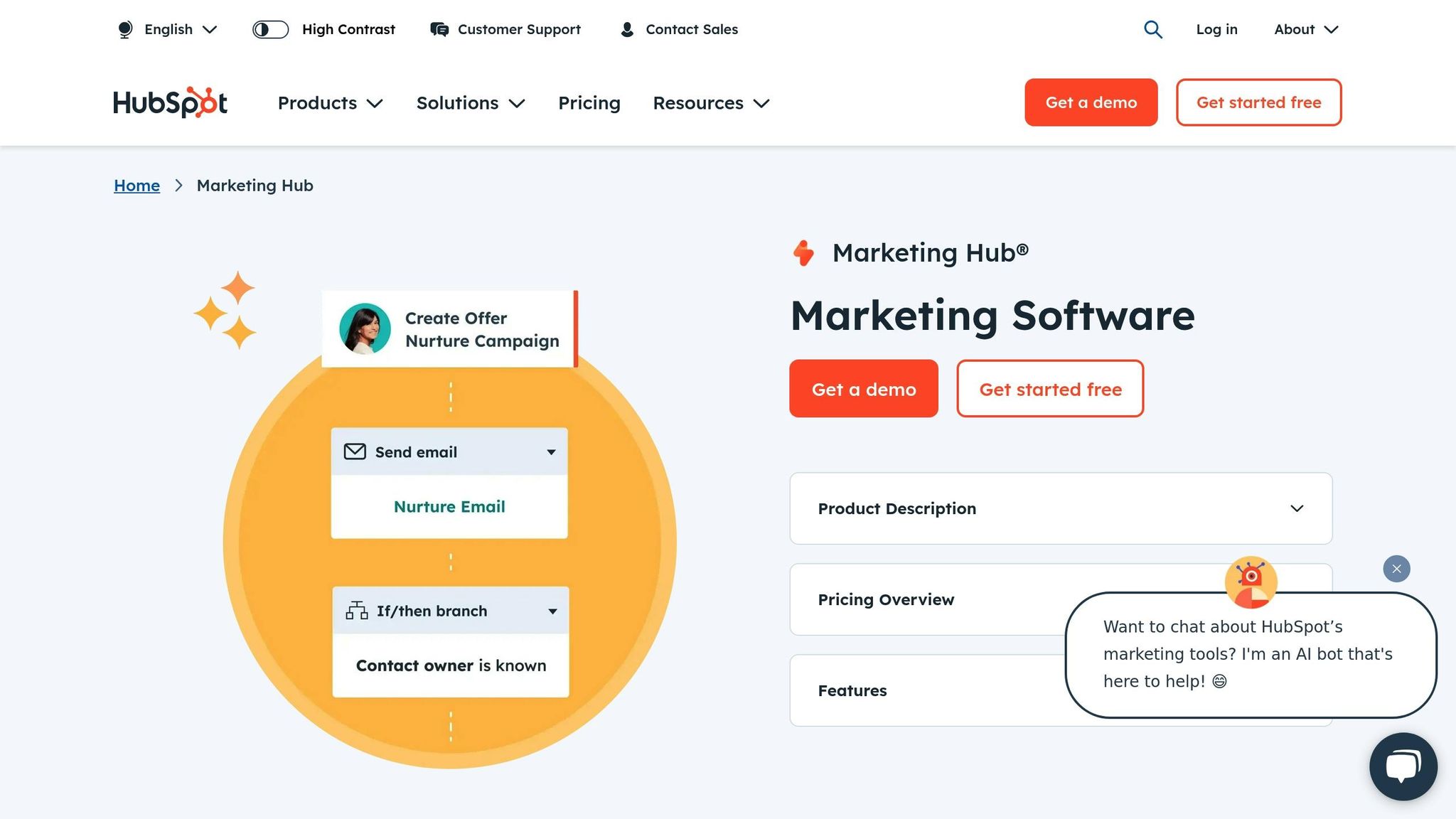
HubSpot Marketing Hub tackles the challenge of engaging both patients and healthcare professionals in the digital health space. With its marketing automation tools, providers can create personalized patient journeys, covering everything from the first interaction to follow-ups after treatment [12]. Features like automated email sequences and appointment reminders streamline communication [11], and the results speak for themselves: after a year, healthcare customers using HubSpot saw their site traffic double, inbound leads triple, and deals closed increase by 73% [10]. This success stems from its ability to consolidate scattered patient data, enabling scalable and personalized care [13].
Healthcare providers can also use HubSpot’s blog builder to drive organic traffic and its social media management tools to schedule posts, engage with patients, and monitor performance through integrated pop-up forms [12]. These features make HubSpot a valuable asset when used alongside other specialized healthcare platforms.
"The versatile and scalable data structure of HubSpot Marketing Hub, paired with its Smart CRM connectivity capabilities, allows teams to engage patients on their terms, with material suited to their needs and preferences."
- 4castagency.com [13]
Technical Audience Targeting and Segmentation
Beyond its content tools, HubSpot excels in audience targeting, especially for highly technical groups. Its advanced segmentation capabilities allow healthcare organizations to create focused audience groups using anonymized or de-identified data, ensuring compliance with privacy standards while enabling precise targeting [17]. This is critical in a field where 55% of healthcare executives report receiving 11 or more vendor calls and emails weekly [16]. HubSpot’s workflow automation, including custom triggers, automated lead scoring, and its Target Accounts feature, simplifies marketing efforts and supports account-based strategies. For example, in 2024, ProperExpression helped Intraprise Health boost inbound revenue by 466% using these tools [16].
Integration with Healthcare Data Systems
While HubSpot Marketing Hub offers robust CRM and marketing automation features, integrating it with healthcare data systems requires extra care. The platform can connect with various healthcare operations to enhance patient engagement and streamline communication [14]. However, since HubSpot is not natively HIPAA compliant [15], healthcare organizations must implement additional safeguards when dealing with protected health information. This is particularly relevant as the clinic management software market is projected to grow from $12.9 million in 2022 to $28.17 million by 2030, with an annual growth rate of 8.8% [15].
3. Salesforce Health Cloud
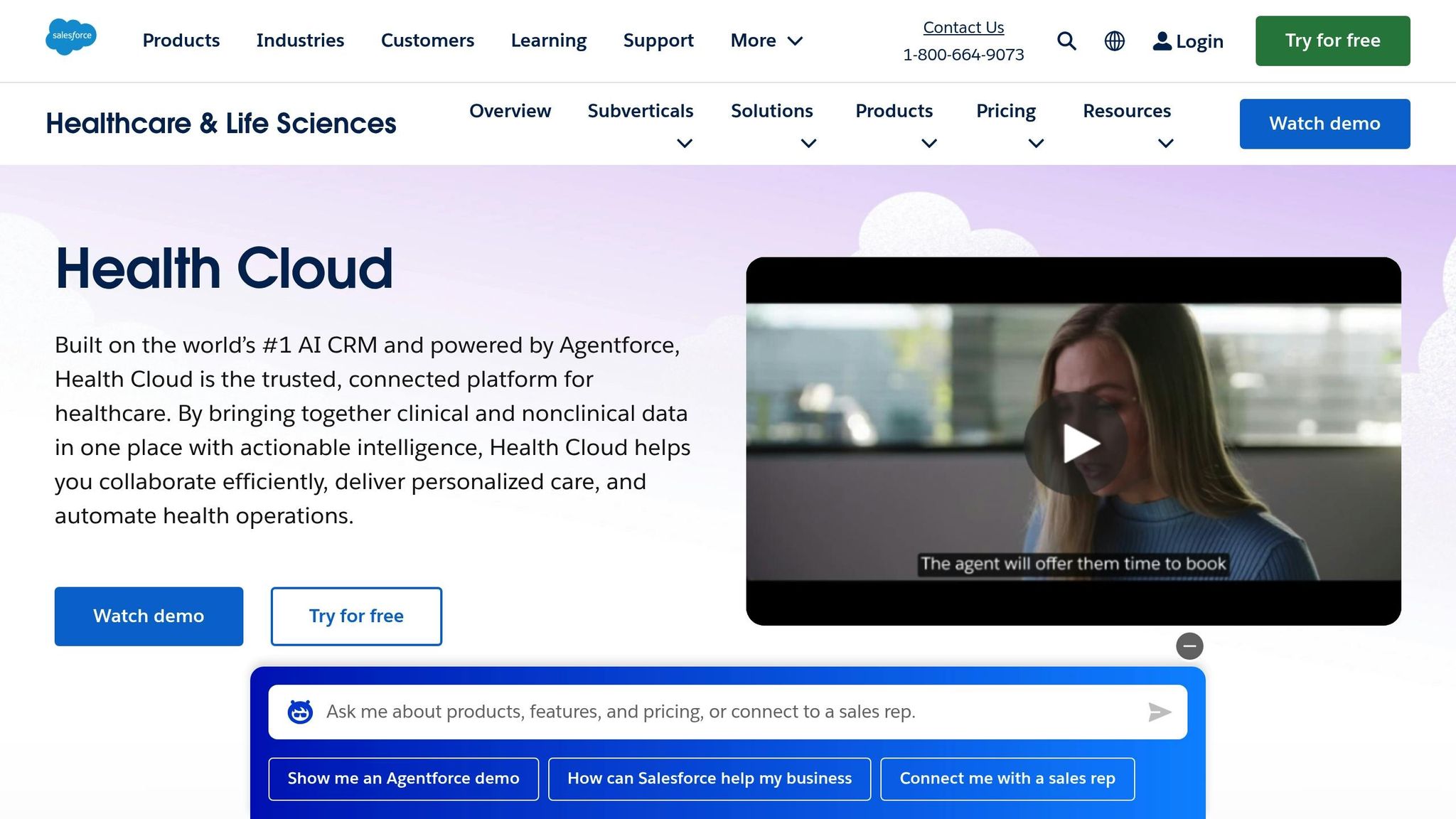
Salesforce Health Cloud is purpose-built to meet the unique needs of digital health marketing. It combines strict compliance with regulatory standards, personalized patient engagement, and smooth data integration, making it a standout platform for healthcare organizations. Unlike general marketing tools, Health Cloud is tailored to handle the complexities of managing sensitive patient data while executing advanced marketing strategies.
Regulatory Compliance (e.g., HIPAA, FDA)
Ensuring regulatory compliance is at the core of Salesforce Health Cloud. The platform is designed to align with HIPAA requirements, providing healthcare organizations with a secure foundation for their marketing activities [18]. For businesses with a Business Associate Addendum (BAA), Health Cloud offers key safeguards like continuous security monitoring and detailed audit logging [19].
To protect sensitive data, Health Cloud employs robust encryption for both data-at-rest and data-in-transit. It also features role-based access controls and multi-factor authentication, meeting stringent standards such as HIPAA, HL7 FHIR, HITRUST, FedRAMP, ASIP Santé, FDA, and GDPR [20]. For organizations seeking even greater security, additional tools like Shield or Government Cloud can be integrated with Health Cloud [20].
However, while the platform provides a strong security framework, the responsibility for proper configuration lies with the customer. As Salesforce states, "It is the customer's responsibility to ensure the secure transmission of PHI data to and from the HIPAA covered services" [19]. This means organizations must fine-tune security settings to prevent unauthorized access and detect suspicious activity.
Once compliance is addressed, Health Cloud focuses on enhancing individual patient engagement.
Patient Engagement and Personalization Capabilities
Health Cloud takes patient engagement to the next level by consolidating clinical data, patient preferences, social factors, and communication history into a single, unified view [21]. This approach fills a critical gap in healthcare, as many health outcomes are influenced by factors like living conditions and socioeconomic status, which are often overlooked by care providers [22].
The platform enables proactive communication through personalized messages, appointment reminders, and wellness tips, all delivered via the patient’s preferred channels [21]. When paired with Marketing Cloud, healthcare providers can create tailored campaigns and patient journeys at scale [22]. For instance, a dermatology clinic could use Health Cloud to compile a list of patients and then leverage Marketing Cloud to send educational content about sunscreen through email, mobile, and social media [22].
AI-driven tools further enhance personalization. Care coordinators can access a patient’s medical history and social determinants - such as transportation challenges or mobility issues - to schedule appointments that fit their needs or recommend virtual visits [21]. After an emergency room visit, Health Cloud can initiate an automated care plan, sending medication reminders, educational materials, and follow-up appointment options [21].
"By surfacing critical factors of a patient's life in a single view, we empower care providers to personalize patient care experiences and improve outcomes with the world's most trusted CRM technology." - Ashwini Zenooz, MD, SVP & GM of Healthcare and Life Sciences at Salesforce [22]
Integration with Healthcare Data Systems (e.g., EHR, HL7)
In addition to its compliance and engagement capabilities, Health Cloud seamlessly integrates with existing healthcare data systems. It is designed to work alongside EHRs and other clinical systems rather than replace them [20]. With support for FHIR and HL7 standards, Health Cloud ensures secure data exchange and enables bidirectional data flow with EHRs and other platforms [24]. Tools like MuleSoft simplify these integrations, connecting Health Cloud with billing systems, EHRs, and other healthcare applications [20][25].
According to a 2023 Gartner report, healthcare CRM solutions like Salesforce Health Cloud are growing at nearly 20% annually [24]. By leveraging a unified view of patient data, organizations can improve adherence to care plans and reduce preventable hospitalizations by over 10%. Proactive communication has also been linked to a 20% drop in no-show rates [24].
To achieve seamless integration, organizations need clear data exchange protocols and tools that align with HL7/FHIR standards. MuleSoft Direct for Health Cloud provides FHIR-compliant connectors, making it easier to access and share EHR data [23][25].
"With Health Cloud, care teams have easy access to clinical and non-clinical patient and member data including current health conditions and medications, appointment history, communication preferences, and data from the EHR and other systems." - Salesforce [25]
4. Google Analytics 4

When it comes to tools designed for digital health, Google Analytics 4 (GA4) stands out by offering insightful data tracking while addressing the unique challenges of healthcare regulations. This platform allows digital health companies to monitor patient journeys across multiple touchpoints, all while navigating the intricate rules of healthcare marketing.
Regulatory Compliance (e.g., HIPAA)
For digital health organizations, ensuring compliance with regulations like HIPAA is a top priority when using GA4. However, it’s important to note that GA4 is not inherently HIPAA-compliant and should never be used on pages that display Protected Health Information (PHI) [30]. Adding to the challenge, Google does not provide Business Associate Agreements (BAA) for GA4 data collection, which increases the risk of inadvertently exposing PHI [30].
"Customers who are subject to HIPAA must not use Google Analytics in any way that implicates Google's access to, or collection of, PHI, and may only use Google Analytics on pages that are not HIPAA-covered." - Analytics Help [28]
Although GA4 avoids storing IP addresses, it still uses them to determine visitor locations. This, combined with city-level demographic data, could potentially lead to HIPAA violations [32]. The Department of Health and Human Services has issued clear guidelines to help organizations prevent the sharing of identifiable health information with tracking platforms like GA4 [31].
To stay compliant, companies can take several proactive steps:
- Mask sensitive URLs before sending them to GA4, ensuring they don’t reveal PHI [30].
- Conduct regular audits of tracking tags to confirm no PHI is being captured or transmitted [29].
- Implement user consent mechanisms to give individuals more control over their data.
By following these precautions, digital health companies can leverage GA4 while minimizing compliance risks. This also allows marketers to focus on GA4’s advanced features, such as audience segmentation, to effectively reach technical audiences.
Technical Audience Targeting and Segmentation
One of GA4’s standout features is its advanced segmentation capabilities, which are particularly useful for targeting technical audiences like healthcare professionals, researchers, and IT decision-makers. The platform enables marketers to create detailed audience segments by grouping data based on specific conditions [26]. Segments can be applied at three levels - user, session, and event - offering a deep dive into audience behavior [26].
GA4 also provides pre-built segments for common scenarios, such as recently active users or frequent purchasers. Its predictive segments can even identify users who are likely to take specific actions, such as signing up for a service [26]. Additionally, GA4’s event-based data model supports cross-device and cross-platform reporting, giving marketers a complete view of technical audience interactions [27]. These capabilities allow for more precise targeting and set the stage for personalized patient engagement.
Patient Engagement and Personalization Capabilities
GA4 excels at tracking patient journeys across web and app platforms, offering a clear picture of how users interact with digital health services [33]. Its Consent Mode integrates seamlessly with Consent Management Platforms, empowering users to control their data - a critical feature for earning the trust of health-conscious consumers [33].
A great example of GA4 in action is the launch of Birdi, a digital pharmacy, where Bounteous implemented GA4 to analyze user behavior across mobile apps and websites. This approach not only improved the patient experience but also adhered to strict privacy guidelines [33].
GA4 also provides audience recommendations to help healthcare companies grow their patient base or explore new specialties [34]. Its machine learning tools offer insights into the pathways visitors take to complete conversions, which is particularly helpful for websites with multiple conversion points [27]. Marketers can further customize the Reports snapshot to quickly access key metrics related to patient engagement [34].
Real-world examples highlight the impact of data-driven marketing in healthcare. For instance:
- Eli Lilly leveraged Campaign Manager 360 to implement personalized marketing strategies, boosting ROI by 12% to 35%, depending on the channel [33].
- St. Jude Children’s Research Hospital transitioned its telethon to a YouTube livestream, raising $3 million in donations and increasing year-over-year contributions by 46% [33].
With digital healthcare and pharma ad spending in the U.S. projected to hit $20 billion by 2025 [33], GA4’s capabilities make it an essential tool for marketers aiming to maximize ROI while staying compliant with healthcare regulations.
5. Doximity

Doximity serves as a powerful connection point between digital health companies and healthcare professionals. With over 80% of U.S. physicians using the platform for networking and patient interactions [37], it has become an indispensable tool for marketers aiming to engage with medical professionals. By combining secure communication tools with advanced marketing features, Doximity is particularly effective for companies in the medical device, pharmaceutical, or healthcare software sectors. Its secure and feature-rich environment ensures effective and compliant outreach.
Regulatory Compliance (e.g., HIPAA, FDA)
Doximity's infrastructure is built to meet stringent healthcare regulations, including HIPAA and SOC 2 Type 2 standards. The platform enforces continuous HIPAA training for all users, ensuring a culture of security-first marketing. Data is safeguarded with strong encryption, while Business Associate Agreements (BAAs), including Enterprise-level options, provide additional layers of protection. Continuous intrusion detection further reinforces security. For digital health companies, this means they can engage with healthcare professionals without worrying about compliance risks.
Targeting and Reaching the Right Audience
Doximity offers access to one of the most concentrated groups of healthcare decision-makers available to marketers. Its user base includes over 375,000 physicians and partnerships with more than 150 health systems [35]. Verified members ensure a high-quality audience for B2B campaigns, making it easier to connect with the right professionals.
A survey by the American College of Physicians places Doximity among the top five apps used by ACP members [37]. This widespread adoption means digital health companies can meet their audience where they’re already active. The platform’s detailed directory of healthcare providers allows marketers to target based on specialty, location, and practice type [36], ensuring campaigns reach the most relevant professionals.
Seamless Integration with Healthcare Data Systems
Doximity’s integration capabilities with healthcare data systems, like EHRs, make it a valuable tool for creating marketing campaigns aligned with clinical workflows. In May 2023, MEDITECH partnered with Doximity to integrate the Doximity Dialer with MEDITECH Expanse Now. This integration allows providers to access patient records and conduct virtual communication from one screen [38].
"Dialer's integration with MEDITECH Expanse Now streamlines clinical workflow and communication" – Jeff Tangney, co-founder and CEO of Doximity [38]
This streamlined approach reduces no-show rates and improves patient response efficiency [38]. For digital health marketers, these integrations highlight practical benefits that resonate with healthcare professionals.
Doximity’s Enterprise plan supports EMR integration, with Dialer Pro priced at $19.99 per user per month, increasing to $24 per user per month starting April 1, 2025 [39]. For companies needing custom integrations, Keragon offers a HIPAA-compliant solution to connect Doximity with other healthcare software [40].
Doximity’s recognition as "Best in KLAS" for its telehealth video platform in both 2022 and 2023 further underscores its technical reliability and appeal. This recognition positions it as a trusted solution for engaging healthcare professionals who prioritize proven and dependable technologies.
6. Sprout Social

Sprout Social is a social media management platform designed to help digital health companies connect with patients and healthcare communities. With a customer base exceeding 900 healthcare organizations [42], it has earned trust in regulated industries.
Regulatory Compliance (e.g., HIPAA)
Sprout Social is upfront about its limitations regarding HIPAA compliance. The platform is not built to handle Protected Health Information (PHI). To address this, it prohibits the sharing, collecting, transmitting, or storing of PHI. However, it offers tools like a limited Business Associate Agreement (BAA), profile and direct message disclaimers, and chatbots that redirect sensitive healthcare conversations to secure channels [42][45].
"Social is a non-negotiable part of driving brand awareness and building connections with patients, physicians and community members. But it can be a challenge for the marketing teams on the digital front lines to overcome the concerns of security and privacy teams - especially at the intersection of HIPAA and social media."
- Jill Florence, Director of Enterprise Sales at Sprout Social [41]
A notable example of Sprout Social’s approach is Health Care Service Corporation (HCSC), the largest customer-owned health insurer in the U.S. By implementing clear social media guidelines and a robust crisis management plan, HCSC has shown how regulated industries can safely use social platforms for marketing while maintaining compliance [47]. This framework ensures secure interactions and fosters effective patient engagement.
Patient Engagement and Personalization Capabilities
Sprout Social enhances patient engagement by promoting healthcare services, sharing educational resources, and fostering relationships that boost patient retention. The platform’s geographic targeting and social listening tools provide valuable insights into patient interactions. Additionally, its AI-powered sentiment analysis helps classify messages, ensuring urgent responses are prioritized. Considering that 30% of consumers expect same-day replies and 23% want responses within 1–2 hours [44], features like Smart Inbox and Saved Replies [42] are crucial for meeting these expectations.
"The [healthcare organizations] who use social listening make more informed decisions about their content strategy."
- Katherine Van Allen, Senior Solutions Engineer at Sprout [43]
These tools allow healthcare organizations to track trending topics and industry conversations, enabling the creation of engaging, evidence-based content. This approach not only educates the public but also combats misinformation effectively.
Integration with Healthcare Data Systems (e.g., EHR, HL7)
Unlike clinical data tools, Sprout Social focuses solely on processing social media data. It does not integrate with Electronic Health Records (EHR) or HL7 systems. Instead, the platform ensures the secure handling of social media data through encryption (both in transit and at rest) and adheres to certifications like SOC 2 Type 2, ISO 27001, and GDPR [46]. This ensures that all social media data remains protected while maintaining compliance with stringent security standards.
7. Hootsuite
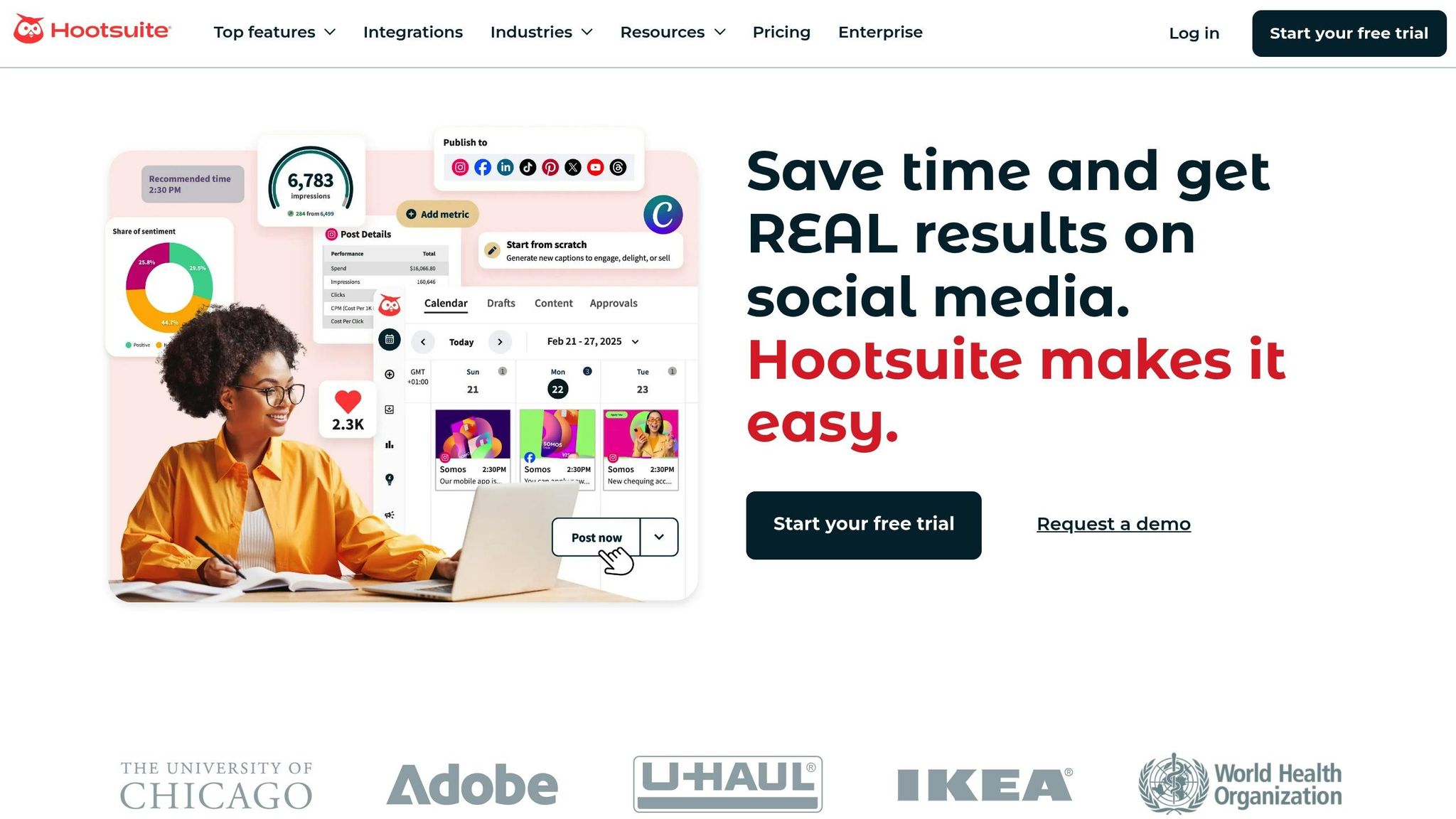
Hootsuite is a powerful platform designed to help digital health companies manage their social media activities while maintaining compliance with strict healthcare regulations. It supports healthcare providers, insurers, and life sciences organizations in creating meaningful, regulated social engagement.
Staying Compliant with Regulations (e.g., HIPAA)
Hootsuite has several built-in tools to ensure compliance with regulations like HIPAA. For instance, it integrates with Proofpoint to flag potentially noncompliant content, uses keyword filters (e.g., "patient", "test results") to prevent the exposure of protected health information (PHI), and enforces strict access controls with role-specific permissions. These features are complemented by a structured content creation and approval process, making it easier to maintain compliance while engaging with patients effectively [49][50][52].
Enhancing Patient Engagement and Personalization
Hootsuite equips healthcare organizations with tools to improve patient interactions. Features like trend search, personalized content suggestions, and brand-approved templates make it easier to deliver consistent and engaging communication [48].
The Hootsuite Inbox consolidates all comments and messages from various social networks into one place, enabling teams to respond quickly and efficiently. For example, Corewell Health saw a 50% reduction in negative sentiment and a 155% increase in engagement after adopting Hootsuite [51].
Michael Yoder, Social Media Consultant at Spectrum Health, highlights the impact:
"Before Hootsuite and even social media, we connected with our patient community by phone and email. Now, we monitor all related conversations from just about anywhere and respond accordingly. Social media is a great opportunity to be more aware, to be more engaged, and provide a better experience." [48]
Hootsuite's OwlyWriter AI helps create engaging content by drafting new posts or repurposing existing ones for different platforms. Ochsner Health effectively used Hootsuite's social listening tools to counter misinformation and boost brand awareness, achieving a 129% increase in engagement and a 5% rise in website traffic from social media [50].
Michael Yoder further emphasizes the value of analytics:
"Analytics are a real driver of success. The social media reporting and competitive analysis we are able to access through Hootsuite provide us with valuable insight into our most engaging content. I feel like the smartest guy in the room when I enter a meeting with data-backed proof points that demonstrate the impact of our social efforts." - Michael Yoder, Lead Digital Marketing Specialist - Social Media, Corewell Health [51]
8. Marketo Engage
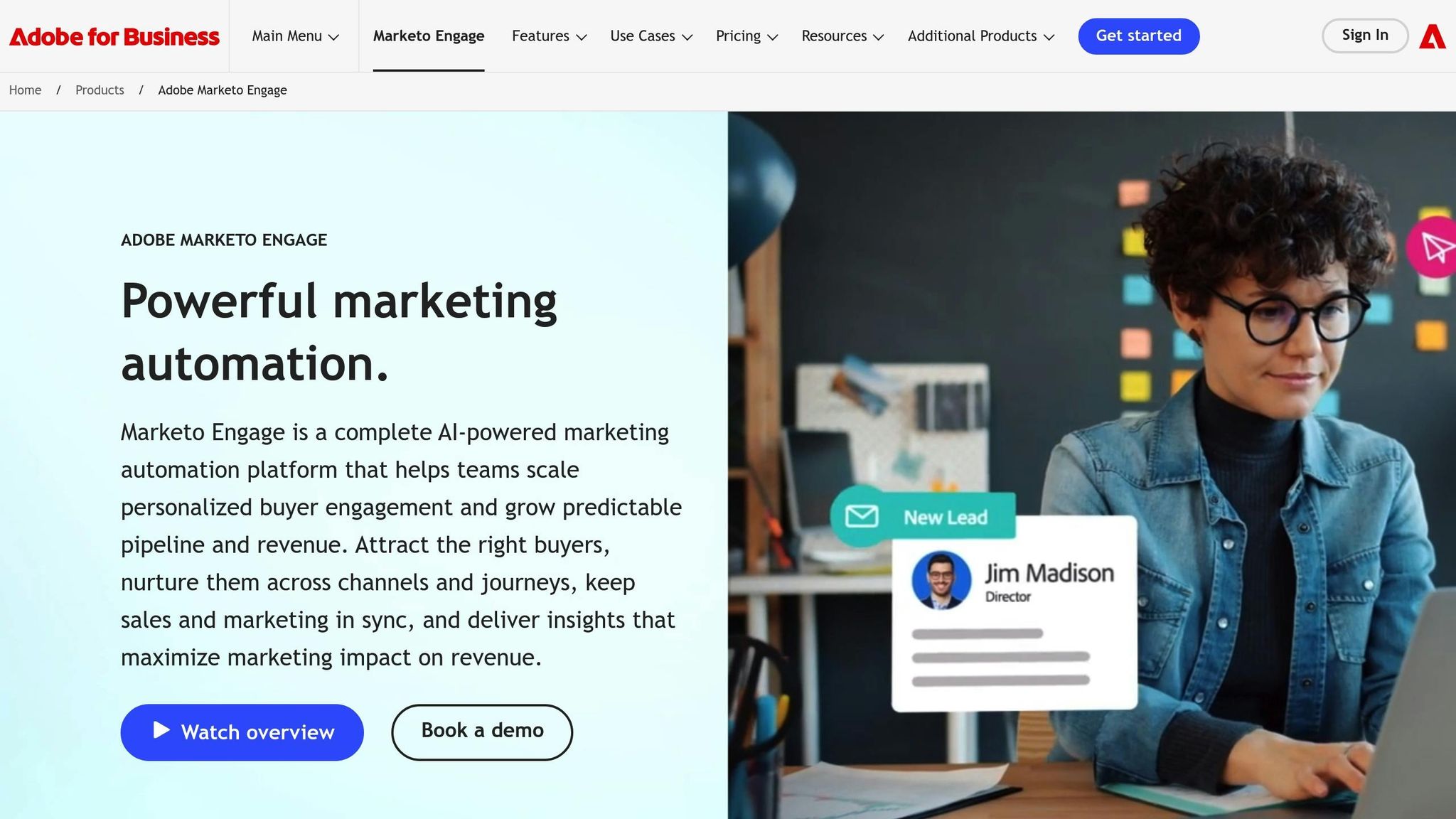
Marketo Engage is a powerful platform designed for digital health marketers, combining compliance, audience targeting, and patient engagement into a single solution. Powered by Adobe's AI-driven marketing automation, it enables healthcare organizations to scale personalized communication with patients and providers while staying compliant with regulatory standards.
Regulatory Compliance (e.g., HIPAA)
Marketo Engage is equipped with a HIPAA-Ready Service designation as part of Adobe's Experience Cloud for Healthcare. This means the platform can handle Protected Health Information (PHI) when properly set up and supported by a Business Associate Agreement (BAA) with Adobe.
"Marketo is HIPAA compliant and can be used to collect, store, analyze, and share Protected Health Information (PHI) between members of the same organization's workforce or systems, provided the email marketing and lead management platform is used in Adobe's Experience Cloud for Healthcare and its use is supported by a Business Associate Agreement." [54]
To meet HIPAA requirements, organizations must subscribe to Adobe's Experience Cloud for Healthcare, establish a BAA with Adobe, and configure the platform to implement the necessary safeguards.
Advanced Audience Targeting and Segmentation
Marketo Engage leverages predictive analytics and advanced segmentation tools to deliver tailored content to specific healthcare audiences. This makes it easier for marketers to target professionals like physicians, researchers, and other technical stakeholders with precision.
GE Healthcare is a standout example of this functionality in action. Glenn Thomas, Chief Marketing Officer at GE Healthcare, highlights:
"Marketo is the center of our marketing engagement. It's not just a marketing automation platform. It's also a source of customer data integration and campaign integration." [55]
Using Marketo Engage, GE Healthcare improved data quality and delivered content at the right stage of the customer journey, generating over $1 billion in pipeline revenue [55]. This demonstrates how advanced targeting capabilities support both compliance and personalization.
Engaging Patients with Personalized Experiences
Marketo Engage's AI-driven personalization tools make it possible to create scalable, multi-channel patient engagement campaigns. From email outreach to automated workflows, the platform helps healthcare organizations connect with patients effectively.
Walgreens Boots Alliance used these features to engage its 120 million customers, increasing retail sales by 155 basis points in just one quarter. Alyssa Raine, Group Vice President of Customer Marketing Platforms at Walgreens, shares:
"The power of Adobe's technology allows us to understand our customers and deliver the unique experiences our customers need to live healthy lives." [56]
Similarly, Kindred Healthcare achieved measurable clinical benefits through targeted campaigns, including a 4.1% reduction in re-hospitalization rates from transition care facilities and a 5.1% reduction from nursing and rehabilitation facilities [57].
Organizations using Marketo Engage have reported significant efficiency and revenue gains, including a 37% reduction in time spent per email campaign, up to $4 million in additional revenue, and pipeline growth of 24x. Some have even cut campaign costs by 400% per prospect [53].
Seamless Integration with Healthcare Data Systems
Marketo Engage also excels in integrating with healthcare data systems, thanks to its robust API capabilities. The platform supports standards like FHIR and HL7, enabling interoperability with electronic health records (EHR) and other systems. For example, Mirketa uses the platform to ensure smooth data exchange between systems [58].
Its CRM integration features connect Marketo with tools like Salesforce Health Cloud. Adobe partner Ranosys has helped numerous organizations align their sales and marketing efforts by integrating Marketo with existing CRM systems [59].
Pfizer offers an excellent example of how Marketo Engage can enhance healthcare system integration. By using Adobe Experience Cloud, including Marketo Engage, Pfizer strengthened its relationships with physicians and patients, creating personalized digital experiences that support treatment journeys [56].
As Stephanie Meyer, Head of Marketing Operations at GE Healthcare, aptly puts it:
"It's not B2B, it's not B2C. It's B2human. That's what Marketo is all about.... Helping us all as marketers better understand our customers." [55]
9. Veeva CRM for Life Sciences
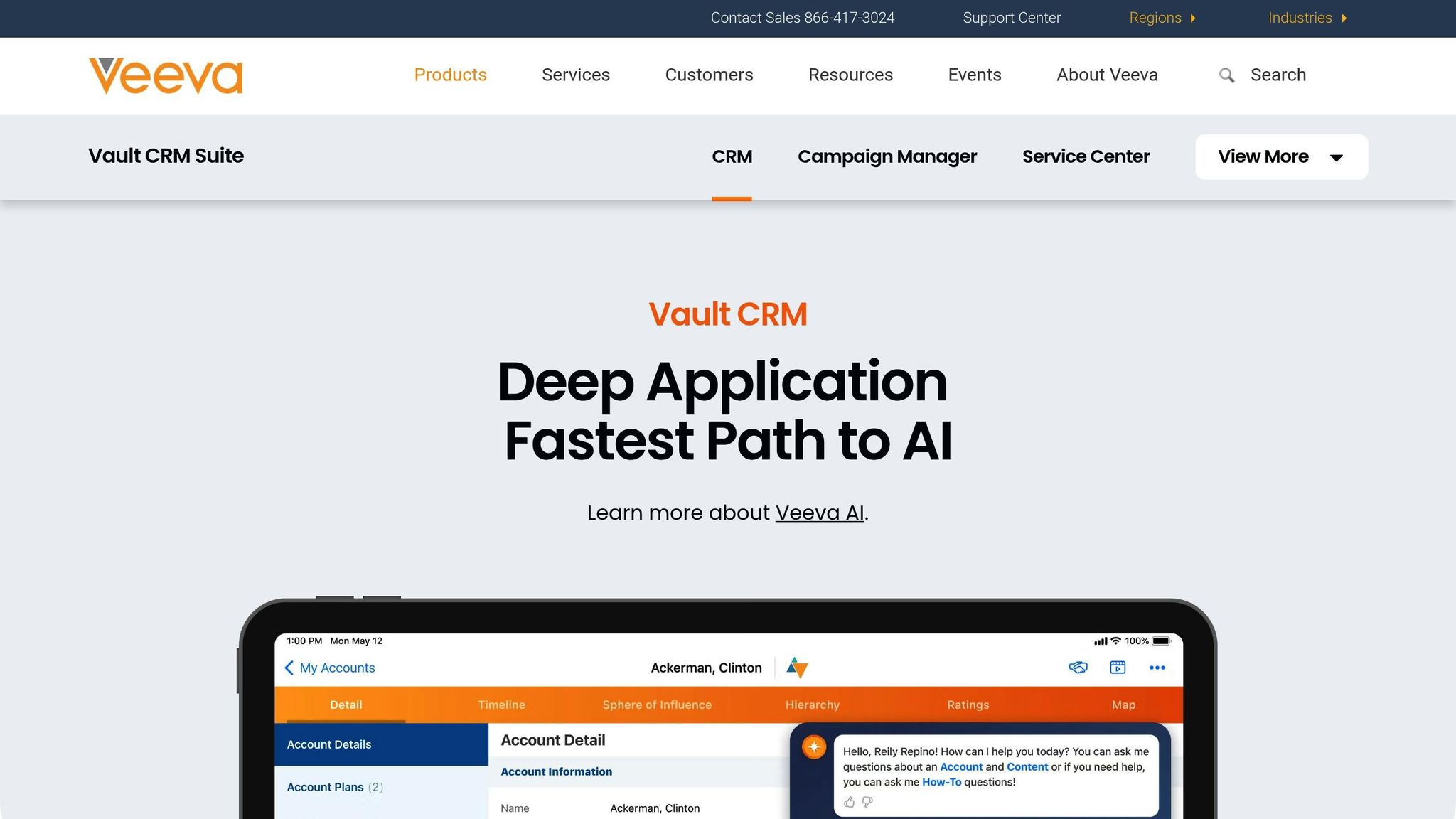
Veeva CRM for Life Sciences is specifically designed for regulated industries, providing digital health companies with a platform that tackles the unique demands of pharmaceutical and life sciences marketing. Unlike generic CRM systems, Veeva CRM combines compliance, data management, and personalized engagement tools into one solution tailored for healthcare professionals (HCPs) and patient interactions.
Regulatory Compliance (e.g., HIPAA, FDA)
Veeva CRM embeds numerous compliance features directly into its framework, helping organizations meet requirements like FDA 21 CFR Part 11, HIPAA, and the Sunshine Act without manual intervention [61].
Key features include audit trails and Part 11-compliant e-signatures, which automatically log user actions and document changes [61]. For those handling Protected Health Information (PHI), the platform ensures security through role-based access controls, field-level protection, and encryption [61].
Sunshine Act compliance is simplified with tools that track HCP spending and sample distribution. Using Veeva OpenData Compliance, the system ensures samples are distributed only to eligible prescribers, adhering to state laws and gift restrictions [61].
The Approved Email functionality is tailored for life sciences marketing, ensuring all emails sent to HCPs have undergone medical-legal review. This feature prevents non-compliant or off-label messaging from being sent [61].
"Compliant at its core, Vault CRM stays up-to-date with evolving regulatory and compliance needs." – Veeva [60]
These compliance-driven features enable effective segmentation of technical audiences.
Technical Audience Targeting and Segmentation
Veeva CRM stands out with its ability to engage healthcare professionals through advanced segmentation, powered by detailed HCP data and AI-driven engagement planning. This ensures personalized recommendations and content delivery for each HCP [60].
A notable example is Boehringer Ingelheim, whose global field teams conducted over one million remote meetings in a year using Veeva Engage. Meeting durations doubled to an average of 20 minutes [63]. Additionally, 90% of shared content achieved open rates, while 30% of conversations were initiated by HCPs themselves [63]. By late 2021, over one million HCPs worldwide were actively using Veeva Engage for digital interactions [63].
Patient Engagement and Personalization Capabilities
Veeva CRM also supports compliant, tailored communication for both HCPs and patients. Through MyVeeva for Patients, study participants can manage appointments, access documents, complete eConsents, and submit patient-reported outcomes (ePROs) from a centralized hub [62].
For HCPs, tools like compliant chat messaging and HCP-focused scheduling within Veeva Engage allow field teams to quickly respond to requests for resources, content, or samples while maintaining compliance [64].
AstraZeneca utilizes the platform's Approved Email customization to enhance their HCP outreach. Kathleen Walpole, Speaker Program Solutions Leader at AstraZeneca, shared:
"Field reps can now create their own personalized email. Approved Email's customization extends the reach and relationships with HCPs." [64]
This real-time responsiveness has enabled field teams to double their digital touchpoints without reducing in-person interactions [64].
Integration with Healthcare Data Systems
Veeva CRM extends its strengths in compliance and engagement with seamless integration capabilities. Using modern REST APIs and pre-built connectors, the platform integrates effortlessly with other Veeva products like Veeva Vault for content management and Veeva Align for territory alignment [65].
For pharmaceutical data needs, Veeva offers solutions like Veeva Nitro and Veeva OpenData, which simplify the integration of prescription data and third-party HCP information, removing the need for custom development [65]. The platform also supports FHIR and HL7 standards, enabling smooth interoperability with electronic health records. Given that over 80% of healthcare organizations exchange HL7 v2 messages and 22% use FHIR APIs, Veeva CRM ensures compatibility with these systems [66].
Boehringer Ingelheim showcases the platform's integration success. Uday Bose, Head of Global Customer Experience Excellence, remarked:
"Our goal to deliver outstanding customer experiences is shared with Veeva and our continued collaboration promises to help transform commercial operations to accelerate launch processes and drive highly personalized engagement." [60]
10. Semrush
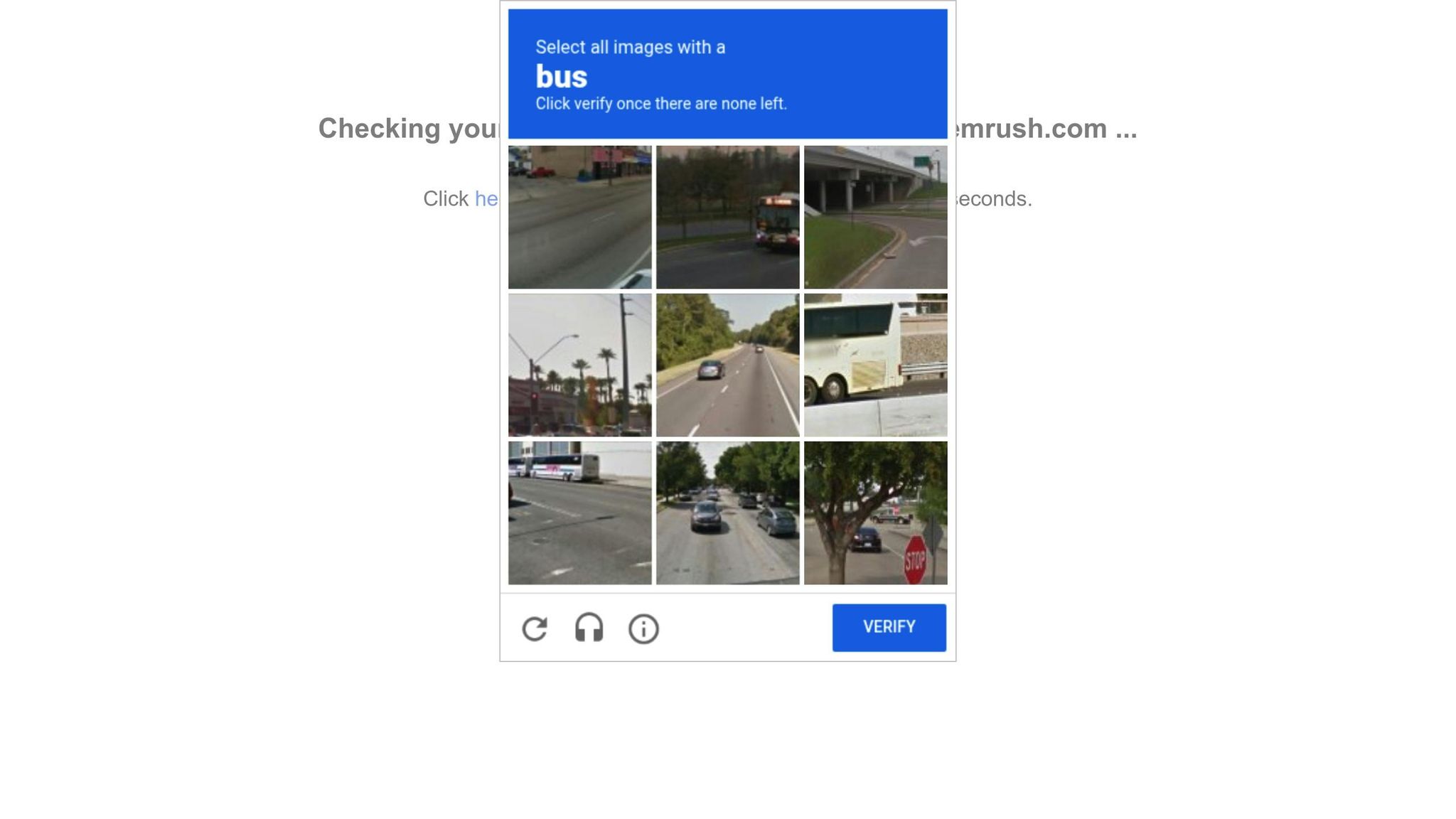
Semrush is a comprehensive digital marketing platform designed to meet the unique needs of digital health companies. Trusted by leading organizations worldwide, it provides data-driven insights that are crucial for healthcare marketing success [68].
With three out of four people turning to online searches for healthcare providers like doctors and dentists, the digital space offers a prime opportunity for health companies to enhance their visibility and credibility among both professionals and patients [67].
Technical Audience Targeting and Segmentation
Semrush excels at helping healthcare marketers reach their target audience through advanced keyword research and competitive analysis. The Keyword Magic Tool uncovers niche-specific content ideas, while the One2Target tool delivers detailed audience insights, including demographics and online behavior patterns [67].
Monash University’s marketing team showcased the platform’s capabilities. Shefali Joshi, Marketing Optimization Analyst at the university, shared:
"With the help of Semrush, we empowered every single marketing team within the university to double their traffic like we did for the central sites." [68]
To keep healthcare content visible in an ever-changing digital landscape, the Position Tracking tool allows marketers to monitor healthcare-specific keywords and adapt strategies as search engine algorithms evolve [67].
Patient Engagement and Personalization Capabilities
Semrush also supports patient engagement by enabling the creation of personalized, locally optimized content. This is especially important for healthcare companies targeting specific geographic areas, as 71% of consumers regularly check reviews before choosing local services, including healthcare providers [67].
Real-world examples underline the platform’s impact. Cosmik Carrot boosted organic traffic by 352.1% for a chiropractor and by 224.1% for a consultant obstetrician in London using targeted SEO strategies [69]. Similarly, Online Marketing Gurus helped a medical software company generate $205,000 in revenue by combining site optimization, local listings, and content marketing [70].
The platform’s AI-driven content tools make it easier for healthcare companies to create patient-centered material that addresses specific health concerns in clear, easy-to-understand language. These tools integrate seamlessly with operational systems via APIs, streamlining the content creation process.
Integration with Healthcare Data Systems
Although Semrush doesn’t directly integrate with specialized healthcare systems, its API allows smooth connections with widely used platforms [72]. Its social media tracking features also provide valuable insights into patient sentiment by monitoring brand mentions across digital channels, helping healthcare companies identify new engagement opportunities [71].
Mario León Rojas, Performance Marketing Specialist at Banco del Sol, describes the platform’s versatility:
"Semrush is like a keyword research tool, Google Trends, Moz, Hootsuite and SimilarWeb in one." [68]
Finally, the Site Audit tool ensures that healthcare websites remain technically sound and accessible, helping companies maintain strong search engine visibility while adhering to accessibility standards [67].
Tool Comparison Table
Here’s a quick breakdown of ten tools, compared across compliance, audience targeting, technical features, and system integration.
| Tool | Key Features | Compliance Capabilities | Technical Audience Targeting | System Integration |
|---|---|---|---|---|
| High-Growth Digital | 90-Day Brand Implementation Sprint, Technical Value Architecture, Brand Translation System | - | Tailored messaging for technical founders, engineering-focused strategies | - |
| HubSpot Marketing Hub | Marketing automation, lead nurturing, content management | GDPR compliance, data encryption, privacy controls | Advanced segmentation, behavioral tracking, persona development | Native CRM integration, 1,000+ app marketplace connections |
| Salesforce Health Cloud | Patient relationship management, care coordination, clinical data integration | HIPAA compliance, PHI protection, audit trails | Healthcare professional segmentation, patient journey mapping | Deep EHR integration, healthcare-specific APIs |
| Google Analytics 4 | Advanced analytics, cross-platform tracking, AI insights | GDPR compliance, data retention controls, consent management | Custom audiences, demographic analysis, behavior flow | Universal tracking, Google Ads integration, BigQuery export |
| Doximity | Medical professional networking, targeted advertising, clinical content | HIPAA-compliant platform, secure messaging, verified physician network | Physician specialty targeting, medical practice segmentation | Limited third-party integrations, closed healthcare network |
| Sprout Social | Social media management, community engagement, reputation monitoring | GDPR compliance, data export capabilities, privacy settings | Healthcare audience insights, demographic targeting | Social platform APIs, basic CRM connections |
| Hootsuite | Multi-platform scheduling, social listening, team collaboration | GDPR compliance, data security, user permissions | Social audience segmentation, hashtag targeting | 150+ social platform integrations, basic analytics export |
| Marketo Engage | AI-powered automation, lead scoring, personalized campaigns | HIPAA compliance available, data encryption, consent management | Advanced lead scoring, behavioral triggers, account-based marketing | Salesforce native integration, extensive API ecosystem |
| Veeva CRM for Life Sciences | Life sciences CRM, regulatory compliance, clinical trial management | FDA compliance, 21 CFR Part 11, audit trails | Healthcare professional targeting, clinical research segmentation | Life sciences ecosystem integration, regulatory reporting |
| Semrush | SEO analysis, keyword research, competitive intelligence | GDPR compliance, data protection, API security | Healthcare keyword targeting, competitor analysis, audience insights | API integrations, limited healthcare-specific connections |
Compliance is a top priority. Failing to meet GDPR standards can lead to fines as high as 4% of global annual revenue or €20 million, while HIPAA violations range from $100 to $50,000 per incident [76]. Both Salesforce Health Cloud and Marketo Engage provide Business Associate Agreements (BAAs) to safeguard PHI [75].
Targeting technical audiences effectively is equally crucial. For example, 77% of people search online for health information, emphasizing the importance of precise digital strategies to connect with the right groups [1][73]. Platforms like Doximity and Salesforce Health Cloud excel in catering to healthcare professionals, while tools such as Google Analytics 4 and HubSpot offer advanced audience insights for broader targeting.
Integration capabilities also play a critical role. They not only help track the patient journey but also tie marketing efforts to ROI [74]. Tools like Salesforce Health Cloud and Veeva CRM shine in healthcare-specific integrations, while HubSpot and Marketo Engage provide more versatile connectivity options.
When choosing a tool, focus on one that aligns with your compliance requirements, technical needs, and digital health marketing goals.
Conclusion
When selecting digital marketing tools, it's critical to find ones that combine strict regulatory compliance with advanced marketing capabilities. Striking this balance is essential - non-compliance can result in hefty fines and damage both reputation and patient trust. With 90% of healthcare executives predicting greater reliance on digital technologies by 2025 [3], the urgency to adopt compliant tools is at an all-time high.
HIPAA violations aren't just costly - they can range from $141 to $2.1 million annually [3] - but they also erode patient confidence. Staying compliant is not just a legal requirement; it’s an ethical responsibility [2].
To choose the right tools, focus on three key factors:
- Regulatory compliance: Look for features like HIPAA safeguards, Business Associate Agreements (BAAs), and robust data protection measures.
- Audience targeting and segmentation: With 61% of U.S. adults actively searching for health information online [77], tools must allow for precise targeting and effective segmentation of healthcare professionals, patients, and technical audiences.
- Integration capabilities: Ensure the tools can effortlessly connect with your existing healthcare systems, CRMs, and analytics platforms. This will give you a unified view of marketing performance and the patient journey.
The U.S. medical advertising market is projected to grow from $22.4 billion in 2022 to $29.2 billion by 2028 [77]. Companies that embrace secure, compliant tools will be better positioned to engage, convert, and build trust with patients [3]. As highlighted throughout, the true value of these tools lies in their ability to navigate the unique regulatory and technical demands of digital healthcare marketing.
FAQs
How can digital health companies use tools like HubSpot Marketing Hub and Google Analytics 4 while staying HIPAA compliant?
To ensure HIPAA compliance when using tools like HubSpot Marketing Hub and Google Analytics 4, digital health companies should focus on a few critical steps:
- Activate HIPAA-compliant features: Implement safeguards like encryption for Protected Health Information (PHI) and assign unique user IDs to monitor access effectively.
- Sign Business Associate Agreements (BAAs): Partner with HubSpot and Google under agreements that commit them to protect PHI as required by HIPAA.
- Avoid collecting sensitive data: Configure Google Analytics to prevent the collection or exposure of PHI, keeping patient information secure.
- Educate your team: Provide thorough training on HIPAA regulations and the importance of safeguarding patient data when using these platforms.
Additionally, conducting regular audits and monitoring your systems is crucial. This helps identify any potential issues early, ensures data security, and keeps your operations compliant with HIPAA standards.
How can digital health companies use marketing tools to effectively reach healthcare professionals and patients?
Digital health companies can connect with healthcare professionals and patients more effectively by blending tailored strategies with data-driven insights. For healthcare professionals, platforms like LinkedIn offer a great space for targeted advertising, while optimizing content around niche, industry-specific search terms can significantly improve visibility. On the patient side, creating engaging content - think blogs or videos that address their specific concerns - paired with smart SEO tactics can help establish trust and foster meaningful engagement.
Another impactful method is using segmented email campaigns. By customizing messages for distinct audience groups and keeping a close eye on engagement metrics, companies can fine-tune their communication to better resonate with their audience. This approach not only makes outreach feel more relevant but also builds trust and boosts conversions by addressing the unique needs of healthcare professionals and patients alike.
How do digital marketing tools work with EHR systems to improve patient engagement and marketing strategies?
Digital marketing tools work hand-in-hand with Electronic Health Records (EHRs) to deliver more tailored and effective patient engagement strategies. By syncing directly with EHR systems, these tools allow healthcare providers to tap into patient data for personalized communication. This could include sending appointment reminders, sharing educational resources, or following up with messages that cater to specific health needs.
This connection doesn't just make marketing efforts more relevant - it also enhances the overall patient experience. By ensuring that communications are timely and meaningful, providers can strengthen their relationships with patients. Plus, automated outreach driven by EHR data boosts engagement and can contribute to better long-term health outcomes.
